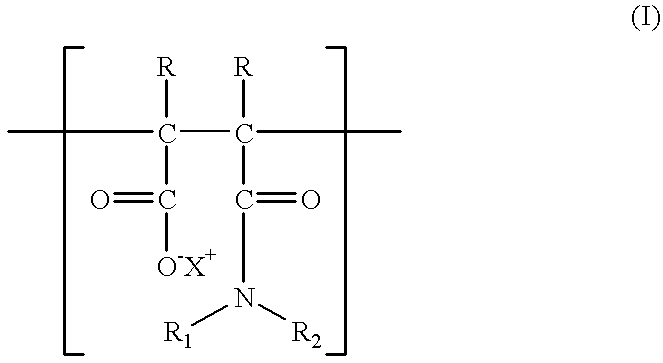Additives for inhibiting gas hydrate formation
a technology of additives and hydrates, applied in the field of additives, can solve the problems of significant financial loss, affecting the production, and affecting the production, and achieve the effects of slowing down the thf hydrate formation, reducing the cost of production, and altering the crystal form of hydrates
- Summary
- Abstract
- Description
- Claims
- Application Information
AI Technical Summary
Problems solved by technology
Method used
Image
Examples
example 2
18.3 g (179 mmol) of 3-dimethylaminopropylamine are initially charged in 53.3 g of butyl glycol and 106.6 g of water at 25.degree. C. and 35.0 g (179 mmol) of an ethylene-maleic anhydride polymer having a maleic anhydride content of 50% by mass (molecular weight according to GPC ca. 10000) in powdered form are added over a period of 2 minutes. The reaction mixture heats up to 50.degree. C. and after the exothermic reaction is complete is stirred further for 2 hours at 50.degree. C. This gives a yellow, fluid solution having a content of 25% and a pH (1% in deionized water) of 9.4. The product has a solubility of 1% in deionized water at pH 1, pH 3 and pH 11.
example 3
7.15 g (70.0 mmol) of 3-dimethylaminopropylamine and 5.12 g (70.0 mmol) of isobutylamine are initially charged in 47.3 g of butyl glycol and 94.5 g of water at 25.degree. C. and 35.0 g (140 mmol) of an ethylene-maleic anhydride polymer having a maleic anhydride content of 40% by mass (molecular weight according to GPC ca. 10000) in powdered form are added over a period of 2 minutes. The reaction mixture heats up to 50.degree. C. and after the exothermic reaction is complete is stirred further for 2 hours at 50.degree. C. This gives a yellow, fluid, slightly turbid solution having a content of 25% and a pH (1% in deionized water) of 8.9. The product has a solubility, to give a transparent solution, of 1% in deionized water at pH 1, pH 3 and pH 11.
example 4
8.33 g (81.5 mmol) of 3-dimethylaminopropylamine and 5.96 g (81.5 mmol) of isobutylamine are initially charged in 44.3 g of butyl glycol and 88.6 g of water at 25.degree. C. and 30.0 g (140 mmol) of a vinyl acetate-maleic anhydride polymer (molecular weight according to GPC ca. 15000) in powdered form are added over a period of 2 minutes. The reaction mixture heats up to 45.degree. C. and after the exothermic reaction is complete is stirred further for 2 hours at 50.degree. C. This gives a yellow, fluid, slightly turbid solution having a content of 25% and a pH (1% in deionized water) of 5.8. The product has a solubility, to give a clear solution, of 1% in deionized water at pH 1, pH 3 and pH 11.
PUM
| Property | Measurement | Unit |
|---|---|---|
| temperatures | aaaaa | aaaaa |
| pressures | aaaaa | aaaaa |
| temperatures | aaaaa | aaaaa |
Abstract
Description
Claims
Application Information
 Login to View More
Login to View More - R&D
- Intellectual Property
- Life Sciences
- Materials
- Tech Scout
- Unparalleled Data Quality
- Higher Quality Content
- 60% Fewer Hallucinations
Browse by: Latest US Patents, China's latest patents, Technical Efficacy Thesaurus, Application Domain, Technology Topic, Popular Technical Reports.
© 2025 PatSnap. All rights reserved.Legal|Privacy policy|Modern Slavery Act Transparency Statement|Sitemap|About US| Contact US: help@patsnap.com



